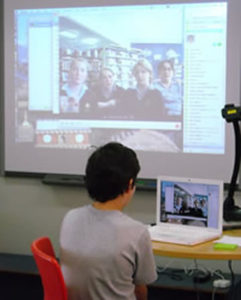
With school budgets continuing to shrink, many educators are turning to free or inexpensive software such as Skype, along with the web cameras that now come standard on most laptop computers, to connect with other classes or colleagues online—forgoing traditional (and more expensive) video conferencing solutions.
Numerous educators said they have used Skype in one form or another for lesson planning or instruction, with most citing its cost (or lack thereof) and ease of use as the main reason for going with the software program.
Skype offers a range of free services, including the ability to make voice or video calls and send instant messages to other Skype users. Users also can pay for services such as making calls from a PC to a landline or cell phone.
Brianna Sylver, president of Sylver Consulting and adjunct professor at the Illinois Institute of Technology’s Institute of Design in Chicago, said her Cross Cultural Research class recently collaborated with a class in Sao Paulo, Brazil, in a manner that called for video conferencing.
After using Skype to collaborate with a teacher in Sao Paulo, the graduate-level class examined the differences between home security companies in the United States and in Brazil using both the slideshow and video capabilities Skype offers.
“The students would present to one another about things they were finding, like what things home security companies in Brazil would need to know if the company wanted to expand its services to the U.S.,” she said.
Sylver said the video function was helpful when her class of 20 students broke into small groups to interact with small groups of students in Sao Paulo.
“We used the webcam capabilities to create more intimate relationships between the students,” she said. “The students would also use [Skype] for collaboration outside of class, using the chat or webcam feature.”
Teachers at New Milford High School in New Jersey also use Skype to enhance their students’ learning experiences, said New Milford principal Eric Sheninger.
“In a sociology class, students spoke to their peers at Van Meter High School in Iowa about perceptions they had of each other and how the current economic crisis is impacting each community,” Sheninger said.
“Our Holocaust class has Skyped with a historian in Israel, where he has given historical insight into the creation and use of the term ‘genocide’ and the history behind labeling the genocide that took place during World War II. He also shared scholarly information on the use of these terms from his years of experience in education at Yad Vashem—Israel’s Holocaust memorial.”
While many educators use Skype as part of their instruction, some colleges and universities use the software as a way to connect with and answer the questions of potential students and their parents.
Bob Garcia, director of admissions at Alma College in Michigan, said he sees Skype being used more and more frequently in student recruitment.
“The main advantage to our use of Skype in communications with prospective students, especially those who are abroad, is that both parties are familiar and comfortable with the technology. It provides us with video, voice, and text options in a free and easy-to-use interface that we are all used to,” he said. “The combination of the economy and a shrinking high school cohort has produced a perfect storm for the need for more cost-effective ways to recruit out-of-state and abroad. Skype meets those needs.”
Not everyone agrees that Skype is a suitable alternative to more traditional video conferencing solutions.
Andre Kostousov, associate director of admissions and international counselor for Northeastern University in Massachusetts, said he has used professional video conferencing software in a previous position. Although Skype is convenient in that it can be installed on almost any computer, it has its drawbacks, Kostousov said.
“Professional video conferencing software produces a much higher quality feed and is much more stable. It allows you to have a clearer and larger picture,” he said.
That argument is echoed by makers of traditional video conferencing solutions, who say users get what they pay for.
Skype’s sometimes poor picture quality is something that Avistar Communications aims to counter with its video conferencing software, said Avistar’s chief marketing officer, Stephen Epstein.
“Because of the architecture, the quality of Skype’s video chats can be poor. The video often pixilates, and the audio is often unsynced. This significantly undermines the success of a video call,” he said. “Avistar’s software ensures that the quality of service is the best that it can be, given every user’s available technology resources, and dynamically adjusts accordingly—instead of degrading the user experience.”
The Avistar C3 platform provides high-definition, multiparty desktop video conferencing. Epstein said the Avistar C3 solutions are ideal for education settings. Desktop video conferencing enhances collaboration, boosts communication, and draws geographically distributed people together, he said.
“Benefits are both soft—faster decision making, enhanced productivity and efficiency—and hard—reducing travel costs and downtime from physical travel,” he said.
Sheninger said Skype is lacking in its video multi-conferencing ability, with another drawback being the need for users’ wireless networks at two simultaneous sites to function properly.
Epstein said Avistar addresses this challenge by including a bandwidth management tool to prevent the overload that can slow networks or crash other applications when using Skype. Avistar also has no limit to the number of participants on a video session, he said.
But even with the potential drawbacks to using Skype in the classroom, many educators said they plan to continue using the software.
Kathy Cassidy, who uses Skype in her first-grade class in the Prairie South School Division in Saskatchewan, Canada, said her use of the software has been completely successful.
“I had not done other video conferencing in my classroom before, and have not tried any other tools that are available. Skype has worked well for me, so I have had no reason to try other tools,” she said.
Links:
Note to readers:
Don’t forget to visit the Next Generation Collaboration resource center. The ability to work together on group projects is seen as an increasingly important skill for the 21st-century workplace, and a growing number of schools are rewriting their curriculum to include opportunities for such collaboration as a result. Go to:
Next Generation Collaboration
- Student programmers solve real-world challenges - July 12, 2010
- Computers make strides in recognizing speech - June 25, 2010
- On new iPhone, a mystery of dropped calls - June 25, 2010
